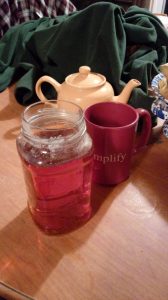 It’s time, no doubt about it. Needles are falling in a not-so-gentle shower on the rug. The cats are practicing their climbing skills. Time to take the tree down.
It’s time, no doubt about it. Needles are falling in a not-so-gentle shower on the rug. The cats are practicing their climbing skills. Time to take the tree down.
Yet it seems like such a waste. A living tree. Surely there must be something to do with it, short of shipping it off to the landfill?
Make tea.
Our tree this year was balsam fir, the most intoxicatingly aromatic of the evergreens. That wonderful smell is good for more than conjuring up holiday memories, though. The fragrant resins are a key part of the tree’s defenses against herbivores–apparently deer and insects don’t appreciate the scent the way we do.
So this year, after the tree was untrimmed, I went foraging for wild edibles in the living room. You could dry the needles, but they also freeze very well if you have space in the freezer.
How to make tea from a tree? It’s pretty simple–simmer a handful of needles for about 10 minutes–less if you don’t like a strong-tasting tea. I have to say the taste is not remarkable–it can be bitter if you heat it too long. Honey helps. 
But the best part, no question, is the steam rising from the simmering pot. It soothes the sinuses, opens the nasal passages, and evokes the depths of the wild forest in your stressed-out soul. Just the simple act of breathing it in makes you feel better. Sometimes I don’t get around to actually drinking the stuff, I just inhale the steam.
However, if I skip drinking the tea, I’m missing out on the fir’s nutrients–like most evergreens, it’s packed with vitamin C, calcium, iron, and other good stuff. It’s mildly antibacterial and helps with sore throats and sinus infections.
The rest of the tree will go outdoors to be a bird-feeder shelter for the local chickadees. Eventually we’ll use the trunk for firewood.
I’m always glad when the holidays are finally over, but I ‘ll miss having a beautiful, sweet-smelling tree in my house. So will the cats.
Note: Yew, a common hedge in gardens and housing developments, is extremely toxic (why they always put it near houses is a mystery–as a kid, I grew up in an apartment complex with hundreds of yew bushes.) Yew has red berries (also toxic) and a yellowish underside to the needles.





Recent Comments